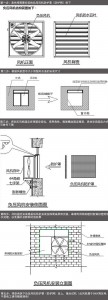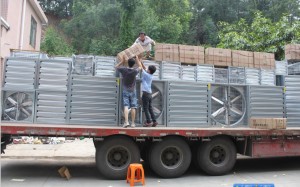Structure
1. Fan casing: The outer frame and shutters are made of galvanized sheet material and are made of molds
2. Fan blade: The fan blade is stamped and formed at one time, fastened with forged screws, and calibrated by computer precision balance
3. Shutters: The shutters are made of high-strength plastic-steel materials, which are tightly closed and have a long service life, mainly when the fan is not in use, dust-proof and rain-proof.
4. Motor: 4-level high-quality copper wire motors are used, generally 380V and 220V.
5. Belt: Common rubber V-belt is used.
6. Diversion hood: guide the air to the exhaust port of the fan, and discharge it to the outside in a centralized manner.
7. Protective net: safety net to prevent human hands and foreign objects from entering the fan.
8. Pulley: The speed of the motor is converted into a low speed through the large and small pulleys, which reduces the running noise of the fan and the load of the motor.
Application field
1. For ventilation and ventilation: it is installed outside the workshop window. Generally, the downwind vent is selected, and the air is drawn out to extract the odorous gas; it is generally used in factories and other applications.
2. Use with wet curtain: It is used to cool down the workshop. In hot summer, no matter how hot your workshop is, the water curtain negative pressure fan system can reduce the temperature of your workshop to about 30C, and there is a certain humidity.
3. For exhaust fans: At present, the performance of general exhaust fans (commonly known as Yanggu fans) is relatively poor, and one exhaust fan cannot blow a few people, but the negative pressure fan is not, whether it is used on the ground or hung in the air. Generally, 4 units are used in a workshop of 1,000 square meters, which means that the whole house is blown by the wind.
Applicable places
1. It is suitable for workshops with high temperature or peculiar smell: such as heat treatment plants, casting plants, plastic plants, aluminum extrusion plants, shoe factories, leather goods plants, electroplating plants, and various chemical plants.
2. Applicable to labor-intensive enterprises: such as garment factories, various assembly workshops, and Internet cafes.
3. Ventilation and cooling of horticultural greenhouses and cooling of livestock farms.
4. It is especially suitable for places that need cooling and a certain humidity. Such as cotton spinning factory, wool spinning factory, hemp spinning factory, weaving factory, chemical fiber factory, warp knitting factory, texturing factory, knitting factory, silk weaving factory, socks factory and other textile factories.
5. Applicable to the field of warehousing and logistics.
Post time: Jun-21-2022





